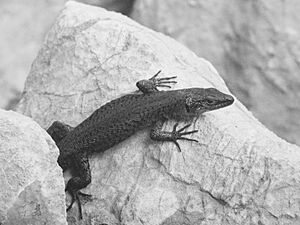Mosor rock lizard facts for kids
Quick facts for kids Mosor rock lizard |
|
|---|---|
 |
|
| Conservation status | |
| Scientific classification | |
| Synonyms | |
|
The Mosor rock lizard (scientific name: Dinarolacerta mosorensis) is a type of lizard. It belongs to the Lacertidae family, which includes many common lizards. You can find this lizard in southern Croatia, Bosnia and Herzegovina, and Montenegro. It might also live in Albania, but scientists are still checking. This lizard gets its name from Mount Mosor, where it was first discovered.
Contents
What Does It Look Like?
The Mosor rock lizard has a flat body. It also has a long head and a thin tail. From its nose to the base of its tail, it grows to about 7 cm (2.8 in). Its tail is usually twice as long as its body.
Its back is a bit shiny. It can be brown, greyish-brown, or olive-brown. It often has darker spots and speckles. The sides of its body are usually darker. Sometimes, the spots are only in the middle of its back.
The underside of the lizard is plain, without spots. In adult lizards, it is usually yellow or orange. Younger lizards might have white or grey bellies. Baby Mosor rock lizards sometimes have bluish tails.
Where Does It Live?
The Mosor rock lizard usually lives in places with a lot of rain. It can be found at high altitudes, from about 450 metres (1,480 ft) to 1,900 metres (6,200 ft) above sea level. Its favorite home is on limestone rocks or in karst areas. These are rocky places found above the treeline.
You might also find it on slopes covered with juniper bushes. It can live in open woodlands too. Sometimes, it lives near natural springs.
Life Cycle and Reproduction
The Mosor rock lizard is active during the day. Females lay eggs once a year. They usually lay about four eggs in one group.
After mating, the female keeps the eggs inside her for about five weeks. Then, she lays them. The eggs hatch about two and a half weeks later. When they hatch, the baby lizards are very small. They are less than 3 cm (1.2 in) long. They also have very long tails.
Why It Needs Our Help
The Mosor rock lizard lives in a small area. All its different groups together cover less than 2,000 square kilometres (770 sq mi). Its habitat is shrinking because of logging, which means trees are being cut down.
This lizard is not very common where it lives. Because of these reasons, the International Union for Conservation of Nature says it is a "vulnerable" species. This means it could become endangered if we don't protect it.


